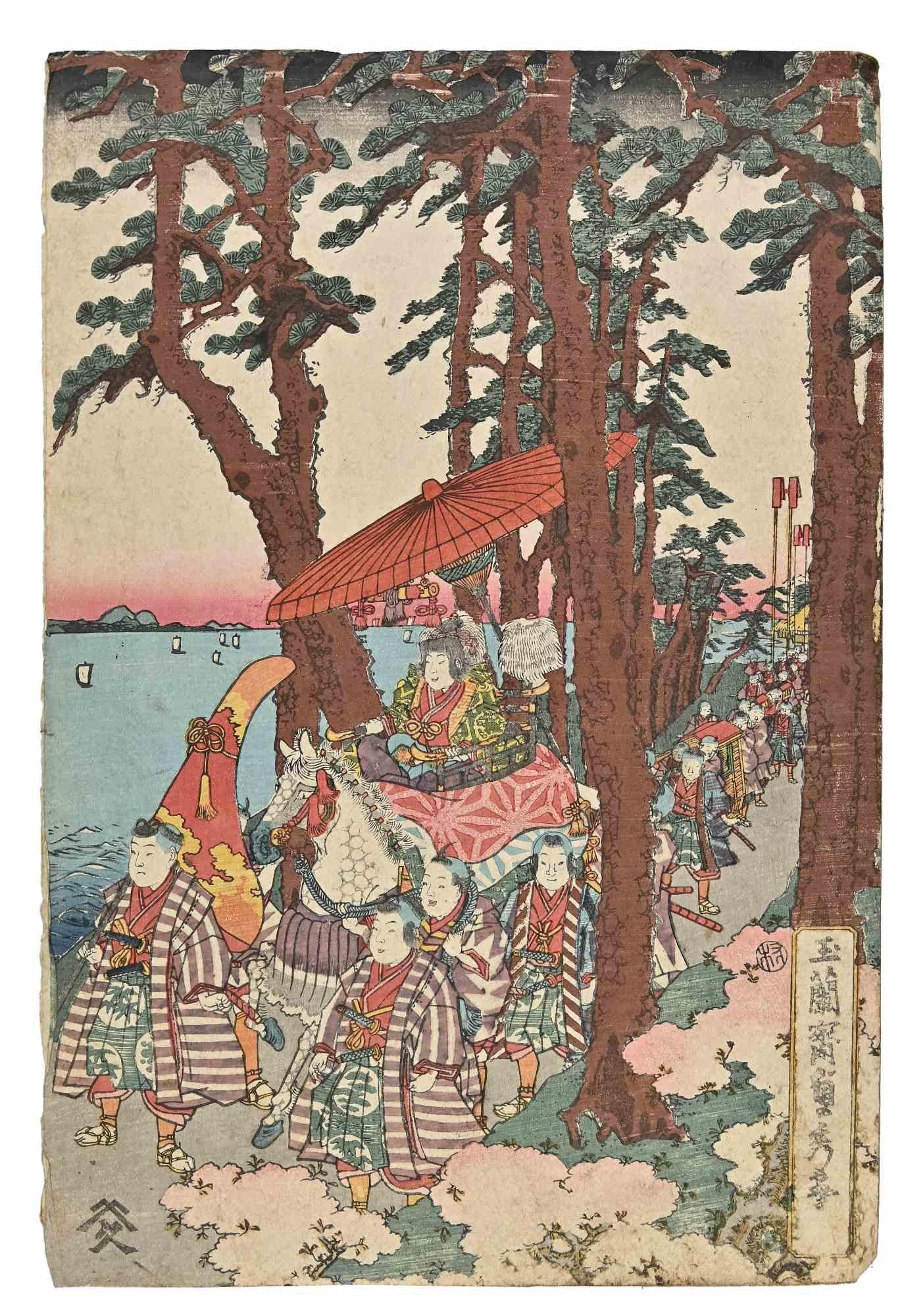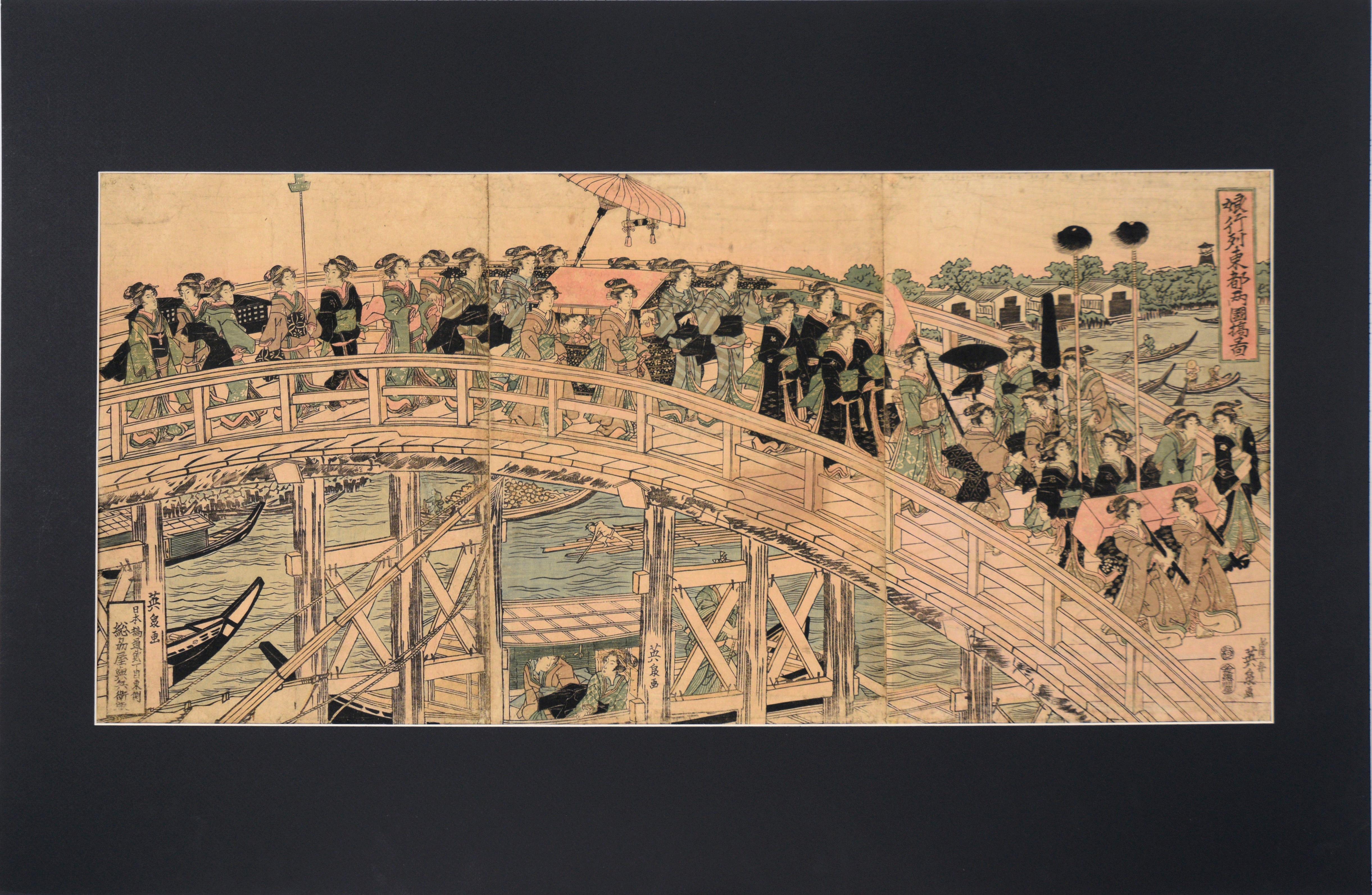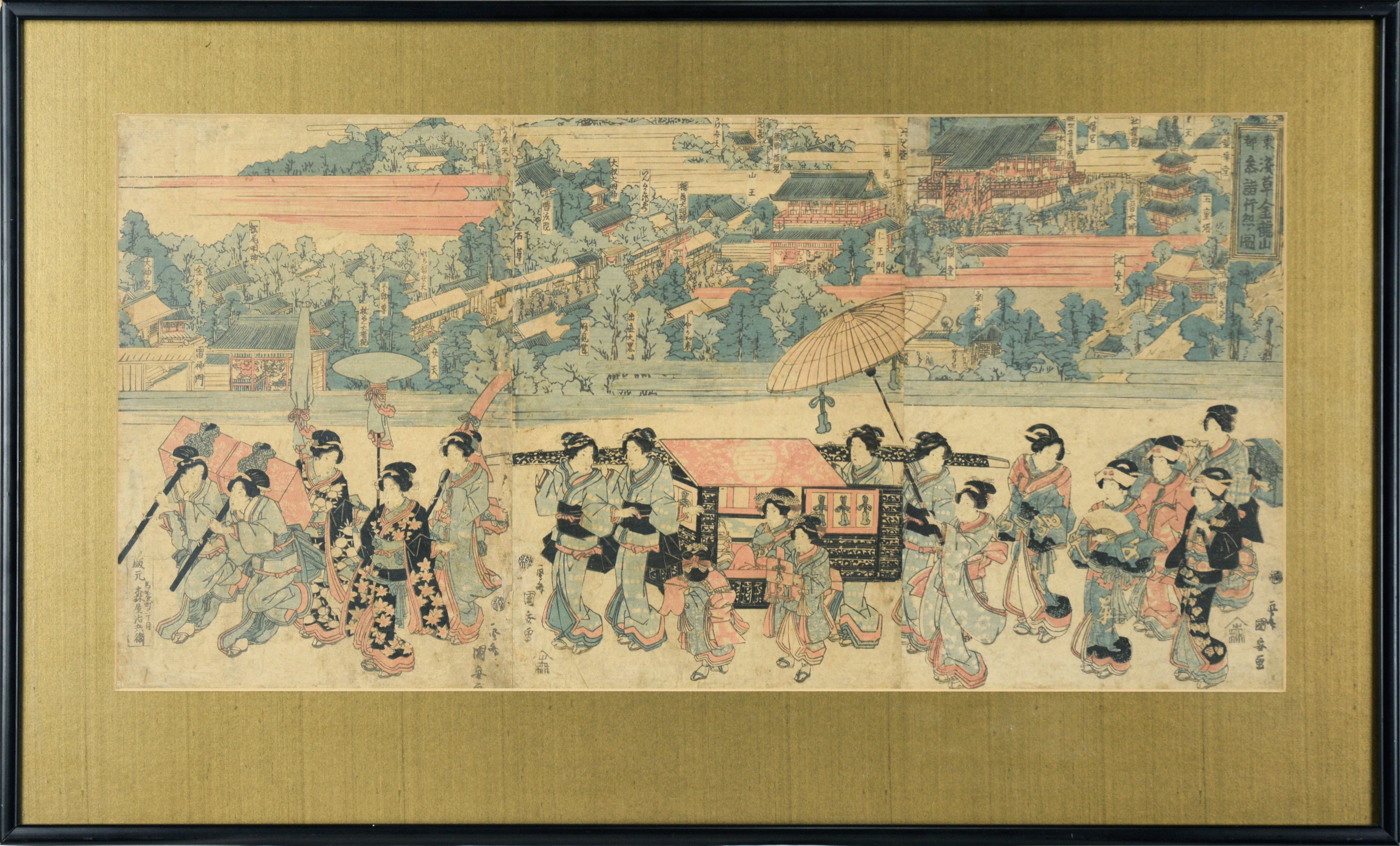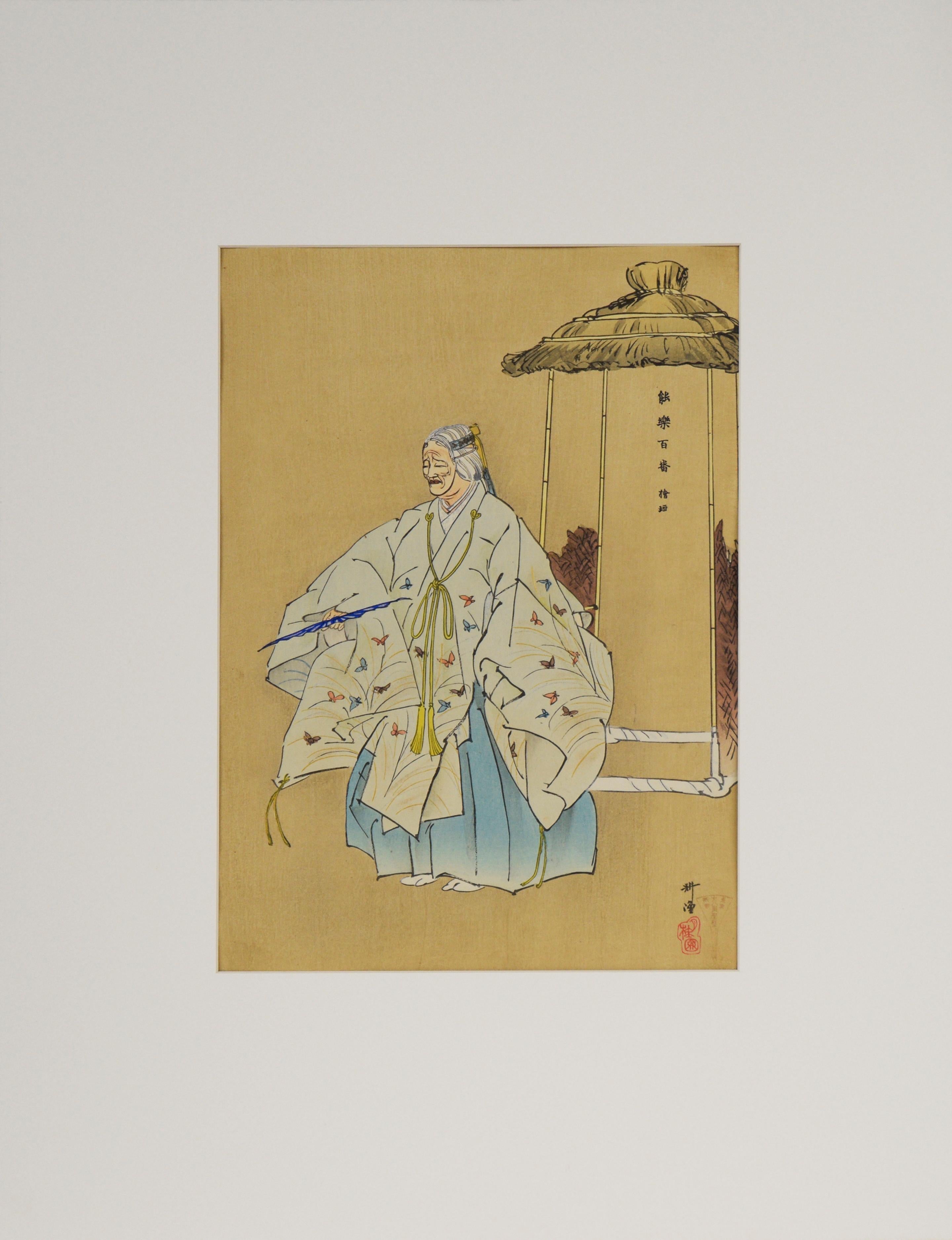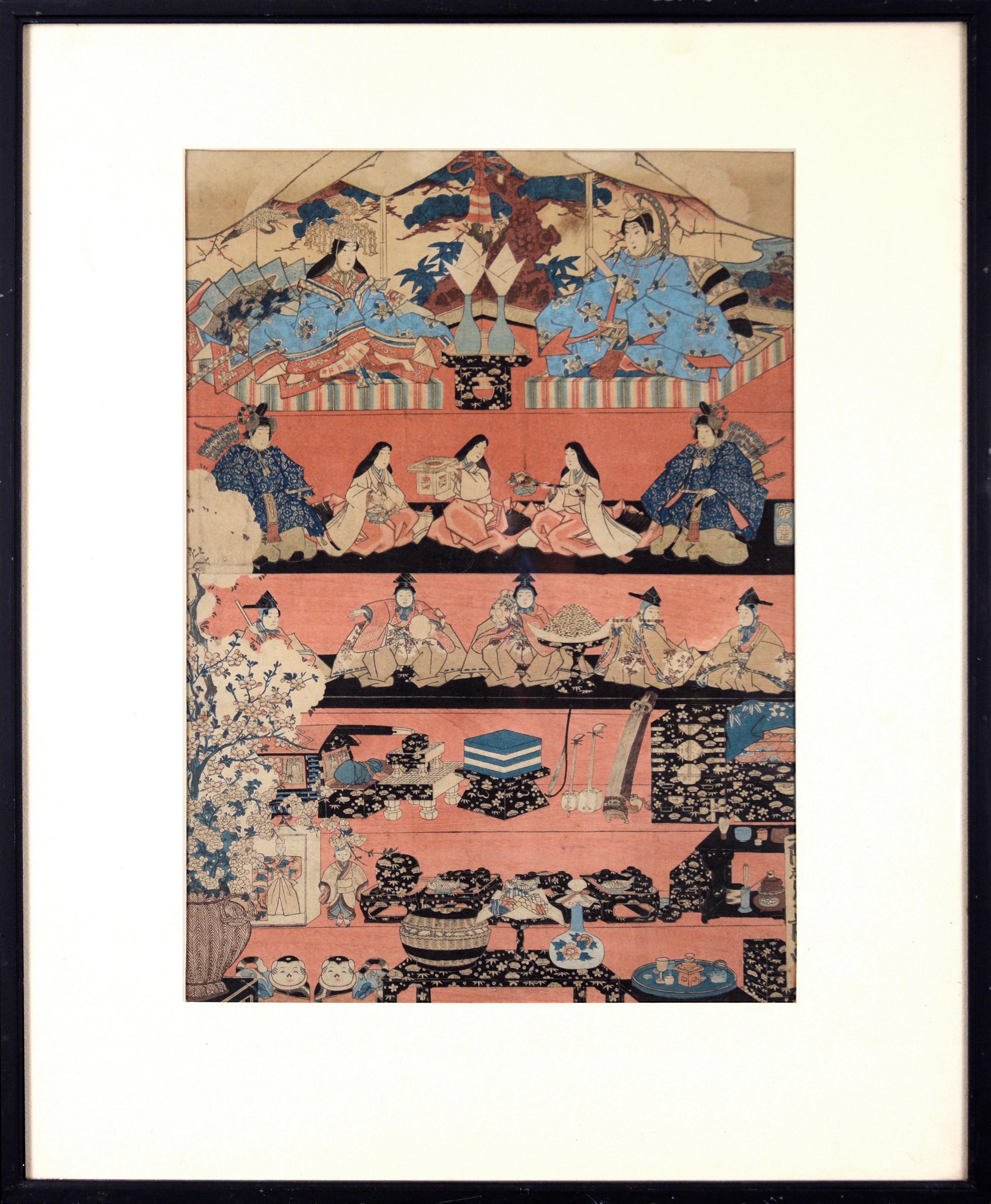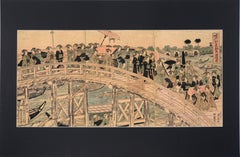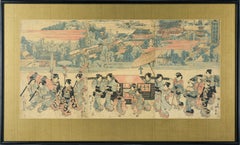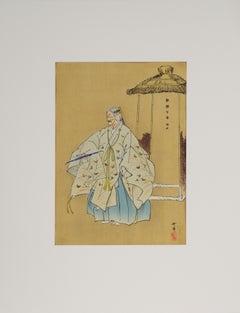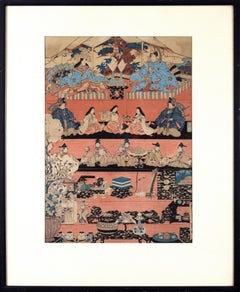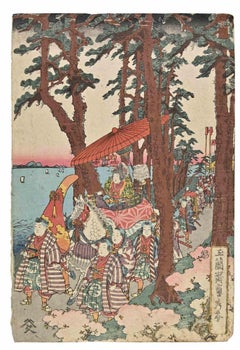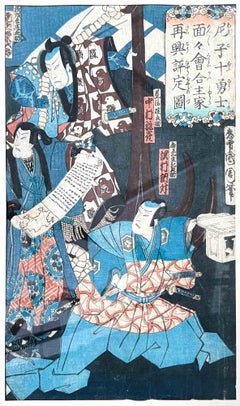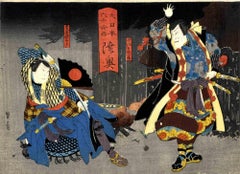Items Similar to Festival Procession Of A Daimyo - Original Woodblock Print
Want more images or videos?
Request additional images or videos from the seller
1 of 6
UnknownFestival Procession Of A Daimyo - Original Woodblock Print18th Century
18th Century
$900
£697.24
€794.25
CA$1,288.56
A$1,407.21
CHF 738.67
MX$16,878.24
NOK 9,303.12
SEK 8,739.21
DKK 5,930.79
About the Item
Procession Of A Daimyo - Original Woodblock Print
Original woodblock print depicting the procession of a Daimyo. Ten Japanese soldiers are seen as they aid in transporting the Daimyo. Daimyo were powerful Japanese magnates, feudal lords who, from the 10th century to the early Meiji period in the middle 19th century, ruled most of Japan from their vast, hereditary land holdings. The soldiers are seen carrying weapons, ceremonial accoutrements, and personal effects.
Unframed. Protected by glass, edged in tape.
Image: 9"H x 18"W
During the Edo period, on a biannual basis, Daimyo were required to travel to Edo, where the Tokugawa shogunate had been based since the early seventeenth century, and take up residence there under the sankin kōtai (alternate attendance) system. Hundreds of retainers are shown transporting weapons, ceremonial accoutrements, and personal effects that bespeak the Daimyo’s military and financial might. Some are mounted on horses; the Daimyo and certain other members of his family are carried in palanquins.
- Creation Year:18th Century
- Dimensions:Height: 9 in (22.86 cm)Width: 18 in (45.72 cm)Depth: 0.5 in (1.27 cm)
- Medium:
- Movement & Style:
- Period:
- Condition:Normal age toning to paper.
- Gallery Location:Soquel, CA
- Reference Number:Seller: N92111stDibs: LU54214368902
About the Seller
5.0
Platinum Seller
Premium sellers with a 4.7+ rating and 24-hour response times
Established in 1986
1stDibs seller since 2014
3,032 sales on 1stDibs
Typical response time: <1 hour
- ShippingRetrieving quote...Shipping from: Soquel, CA
- Return Policy
Authenticity Guarantee
In the unlikely event there’s an issue with an item’s authenticity, contact us within 1 year for a full refund. DetailsMoney-Back Guarantee
If your item is not as described, is damaged in transit, or does not arrive, contact us within 7 days for a full refund. Details24-Hour Cancellation
You have a 24-hour grace period in which to reconsider your purchase, with no questions asked.Vetted Professional Sellers
Our world-class sellers must adhere to strict standards for service and quality, maintaining the integrity of our listings.Price-Match Guarantee
If you find that a seller listed the same item for a lower price elsewhere, we’ll match it.Trusted Global Delivery
Our best-in-class carrier network provides specialized shipping options worldwide, including custom delivery.More From This Seller
View AllMitate of a Daimyo's Procession Crossing Ryogoku Bridge - Woodblock Print
By Keisai Eisen
Located in Soquel, CA
Mitate of a Daimyo's Procession Crossing Ryogoku Bridge - Woodblock Print
Woodblock print of a procession by Keisai Eisen (Japanese, 1790–1848). Terrific triptych of a procession of...
Category
Early 19th Century Edo Figurative Prints
Materials
Ink, Rice Paper, Woodcut
The Pilgrimage Procession to Kinryuzan Temple at Asakusa in the Eastern Capital
By Kuniyasu
Located in Soquel, CA
Japanese Parade - Woodblock Print
Japanese woodblock print by Utagawa Kuniyasu (歌川 国安) (Japan, 1794–1832). Japanese women, dressed in blue and red kimonos, are the focal point. A vi...
Category
Mid-19th Century Edo Figurative Prints
Materials
Paper, Ink, Woodcut
One Hundred Prints Of The Noh - 1925 Original Japanese Woodblock Print
Located in Soquel, CA
One Hundred Prints Of The Noh - 1925 Original Japanese Woodblock Print
Original Japanese woodblock print by Tsukioka Kogyo (Japanese, 1869...
Category
1920s Edo Figurative Prints
Materials
Ink, Rice Paper, Woodcut
"Various Himochi" Wagashi Festival Japanese Woodblock Print by Utagawa Toyokuni
By Utagawa Toyokuni
Located in Soquel, CA
"Various Himochi" Wagashi Festival Japanese Woodblock Print by Utagawa Toyokuni
Rare oversized early 19th century 5-tiered woodblock by Utagawa Ichiyosai Toyokuni, (Japan, 1769-1825), a Japanese lord and wife oversee a sekku festival of food, music, and dolls or toys. '"oshi" is the first day of “Mi (Snake)” in the third month of the lunar calendar. This day, known in modern Japan as the Girls' Festival, originated in China as a form of purification ceremony in which water and drinking peach blossom wine were used to drive away evil. Many kinds of hishi-mochi appear in this picture of hina ningyo (dolls associated with Hinamatsuri, or the Girl’s Day) from Omochae.
The custom of eating special dishes at events throughout the year and at milestones in people's lives has existed since ancient times. This paragraph specifically focuses on the annual event called sekku, and life events that involve eating sweets. Joshi is the first day of “Mi (Snake)” in the third month of the lunar calendar. This day, known in modern Japan as the Girls' Festival, originated in China as a form of purification ceremony in which water and drinking peach blossom wine were used to drive away evil. According to the Keiso saijiki, in ancient China, on the third day of the third lunar month, people ate “ryuzetsuhan,” which is the juice of gogyo (Jersey cudweed) mixed with rice flour and nectar. In Japan, there is a record in the Heian period history book Nihon Montoku tenno jitsuroku [839-5] that it was an annual event to make kusamochi using gogyo on the third day of the third month of the lunar calendar, which may have been influenced by Chinese customs.
The tradition of eating kusamochi on the third day of the third month of the lunar calendar continued after that. By the Edo period, however, hishimochi had come to be used as a sweet to serve on the third day of the third month. A picture of a hishimochi is included in the Morisada manko , which we mentioned in Part 1. According to it, hishimochi in the Edo period were often three layers of green-white-green instead of the now common red-white-green. However, it is possible to see from our collection that not all hishimochi were made in this way. Omochae published in 1857, is a good example. Omochae is a type of ukiyoe print...
Category
1820s Edo Figurative Prints
Materials
Ink, Rice Paper, Woodcut
"First Horse Day, 1896" - Chiyoda Palace - Japanese Woodblock by Chikanobu Yoshu
By Toyohara Chikanobu
Located in Soquel, CA
"First Horse Day, 1896" - Chiyoda Palace - Japanese Woodblock by Chikanobu Yoshu
Colorful and expressive court scne by Toyohara Chikanobu,"Yoshu" (Japanese, 1838-1912).
This is the r...
Category
1890s French School Figurative Prints
Materials
Ink, Rice Paper, Woodcut
"Enshoku Sanju-roku Kasen" (Thirty-six Enchanting Flowers) Woodblock on paper
By Toyohara Kunichika
Located in Soquel, CA
"Enshoku Sanju-roku Kasen" (Thirty-six Enchanting Flowers) Woodblock on paper
Elegant woodblock print by Toyohara Kunuchika (Japanese, 1835-1900). Three women are in talking with each other inside, while a man waits outside holding a bag of some kind. The colors in this piece are rich and saturated, primarily blues, greens, and purple.
Mat size: 16"H x 20"W
Paper size: 14.75"H x 9.88"W
Born in 1835, Toyohara Kunichika grew up in the Kyobashi district of Edo in the midst of merchants and artisans. In 1848, at age 13, he was accepted as an apprentice into the studio of Utagawa Kunisada I...
Category
1880s Edo Figurative Prints
Materials
Ink, Rice Paper, Woodcut
You May Also Like
Parade - Woodblock Print by Utagawa Kunisada - Mid-19th Century
By Utagawa Kunisada (Toyokuni III)
Located in Roma, IT
Celebratory Parade is an original Woodcut print realized in mid 19th century after Utagawa Kunisada.
Good condition and Beautiful colored woodblock print.
This wonderful modern a...
Category
Mid-19th Century Modern Figurative Prints
Materials
Woodcut
Kabuki Scene - Woodcut by Toyohara Kunichika - Late 19th Century
By Toyohara Kunichika
Located in Roma, IT
Kabuki Scene: Teramoto Life, Death Nosuke, Sawamura Bansho is a wooduct print realized by Kunichika Toyohara (1835-1900) in the late 19th Century.
In very good condition, includes ...
Category
19th Century Modern Figurative Prints
Materials
Woodcut
Kyoka-Tokaido - Woodcut after Utagawa Hiroshige -1925
By Utagawa Hiroshige
Located in Roma, IT
Kyoka-Tokaido is an original modern artwork realized after Utagawa Hiroshige (1797 – 12 October 1858) in 1925.
Woodcut Print Chuban Yokoe Format.
Repri...
Category
1920s Modern Figurative Prints
Materials
Woodcut
Kabukie - The Province of Rokuok - Woodcut by Utagawa Kunikazu - 1862
By Utagawa Kunikazu
Located in Roma, IT
Kabukie - The Province of Rokuoku is an original artwork realized in 1862 by Utagawa Kunikazu (1830 - 1919)
Chuban.
From the series "Dai Nippon rokuju of Rikuoku" (60 provinces of Glorious Japan), The Province of Rokuoku.
Meeting of the two rivals in the forest at night, Tanigoro with sumo apron and fan with the national colours.
Signed: Kunikazu.
Good impression, backed, glued at corners, oxidation, centrefold, a little bit rubbed.
Utagawa Kunikazu (1830 - 1919) was a printmaker from Osaka. He had a famous teacher, the ukiyo-e artist Kunisada Utagawa...
Category
1860s Modern Figurative Prints
Materials
Woodcut
Kabuki Scene - Woodblock Print by Utagawa Kunisada - Mid-19th Century
By Utagawa Kunisada (Toyokuni III)
Located in Roma, IT
Kabuki Scene is an original Woodcut print realized in mid 19th century after Utagawa Kuniyoshi (1797-1861).
Good condition and Beautiful colored woodblock print.
This wonderful mo...
Category
Mid-19th Century Modern Figurative Prints
Materials
Woodcut
Kabuki Scene- Woodcut by Toyohara Kunichika - The Late 19th Century
By Toyohara Kunichika
Located in Roma, IT
Kabuki Scene is a Japanese multi-colored woodcut tryptich realized around the end of the 19th century by Toyohara Kunichika (1835 - 1900).
Original woodcut on paper. The artwork is ...
Category
19th Century Modern Figurative Prints
Materials
Woodcut
More Ways To Browse
10th Century
Prayer At Valley Forge
Richard Yarde
Robert Elliot
Robert Gibbings
Romare Bearden Poster
Ronald King
Roy Lichtenstein Reflections
Rufino Tamayo Signed
Russian Woodcut
Saint Genie
Salvador Dali Green
Salvador Dali Signed Prints Bullfight
Secession Poster Vienna
Shepard Fairey Large
Signed Charles Bragg
Tadanori Yokoo
Toshusai Sharaku
